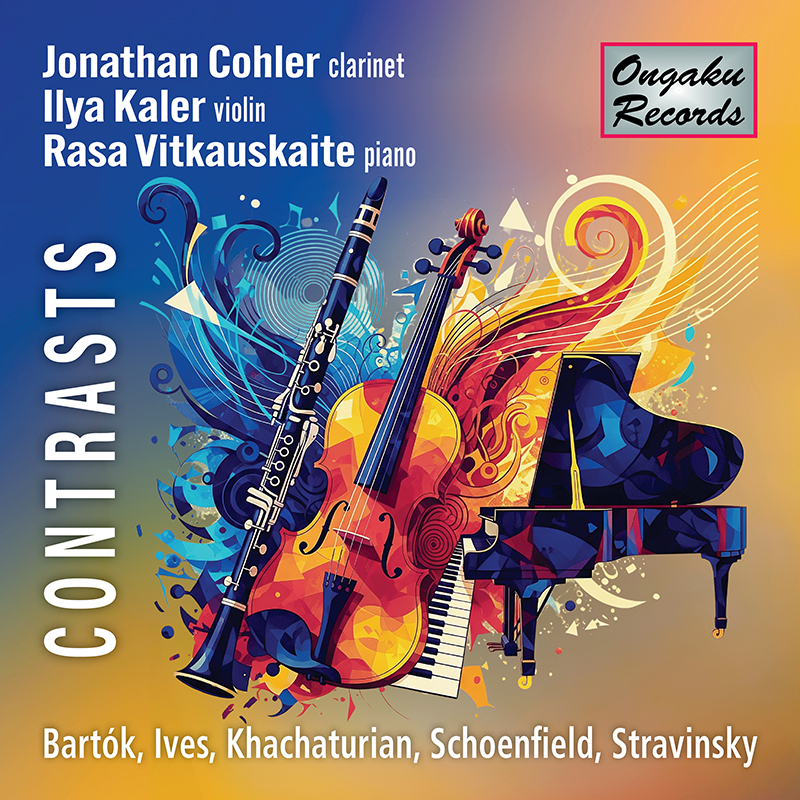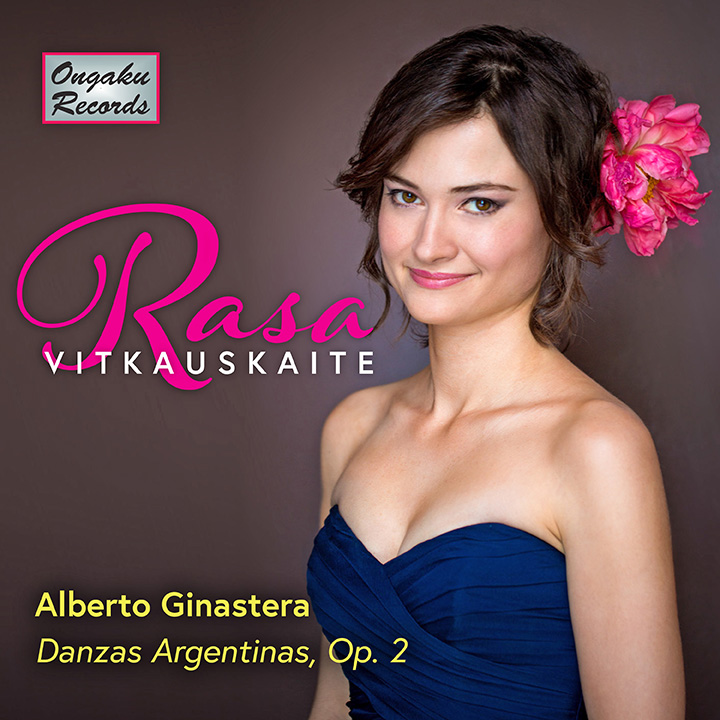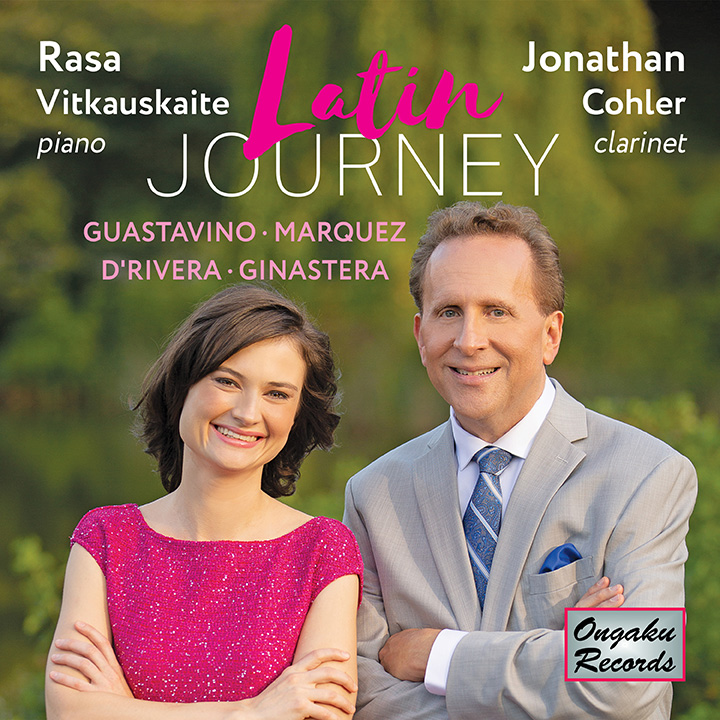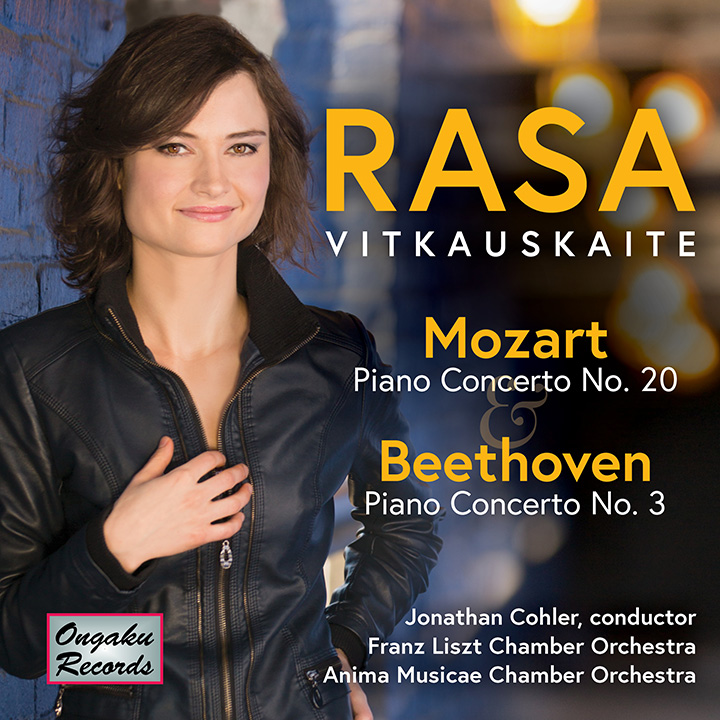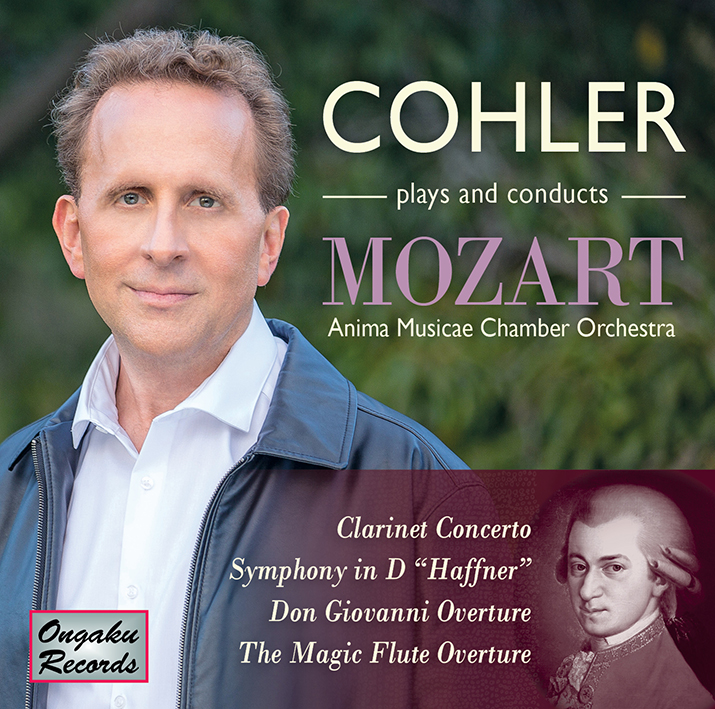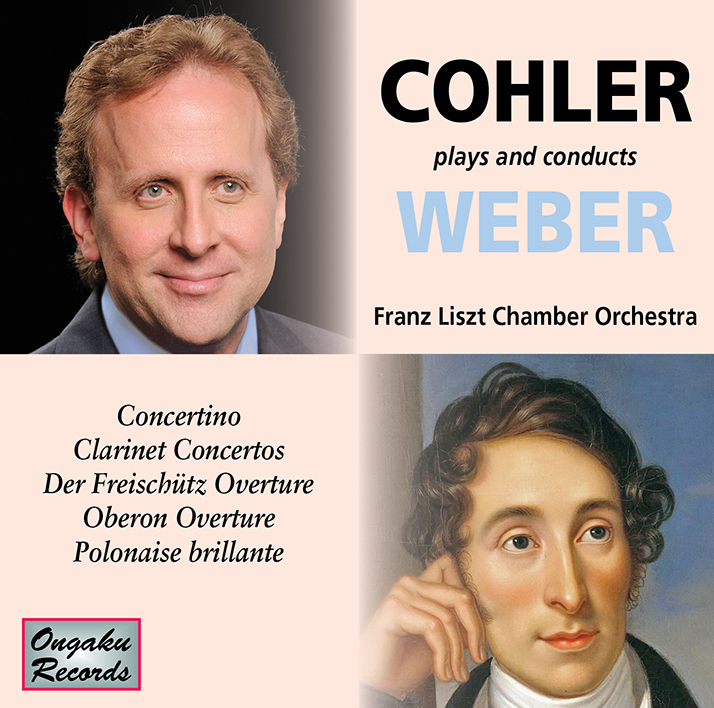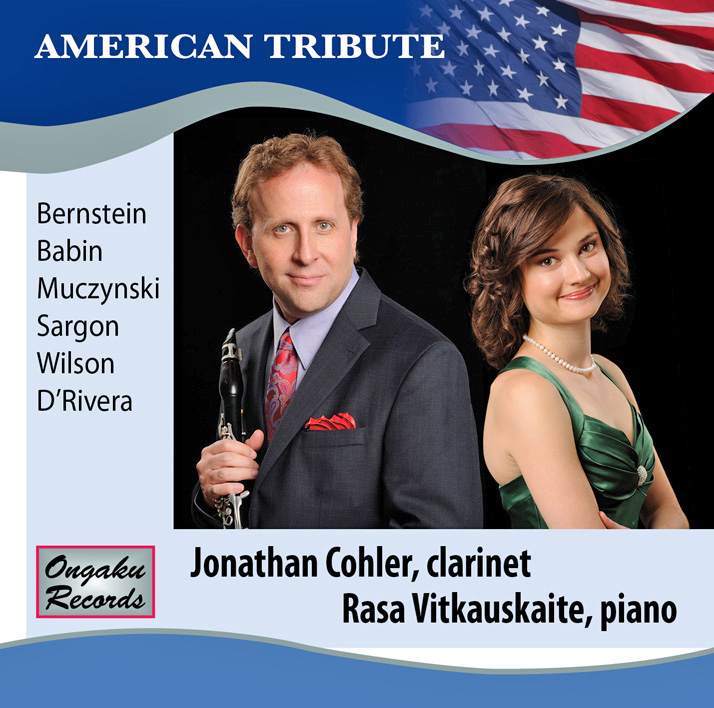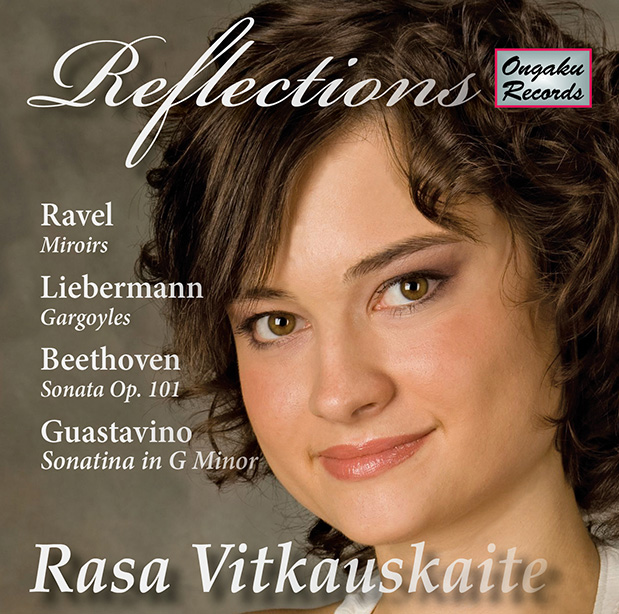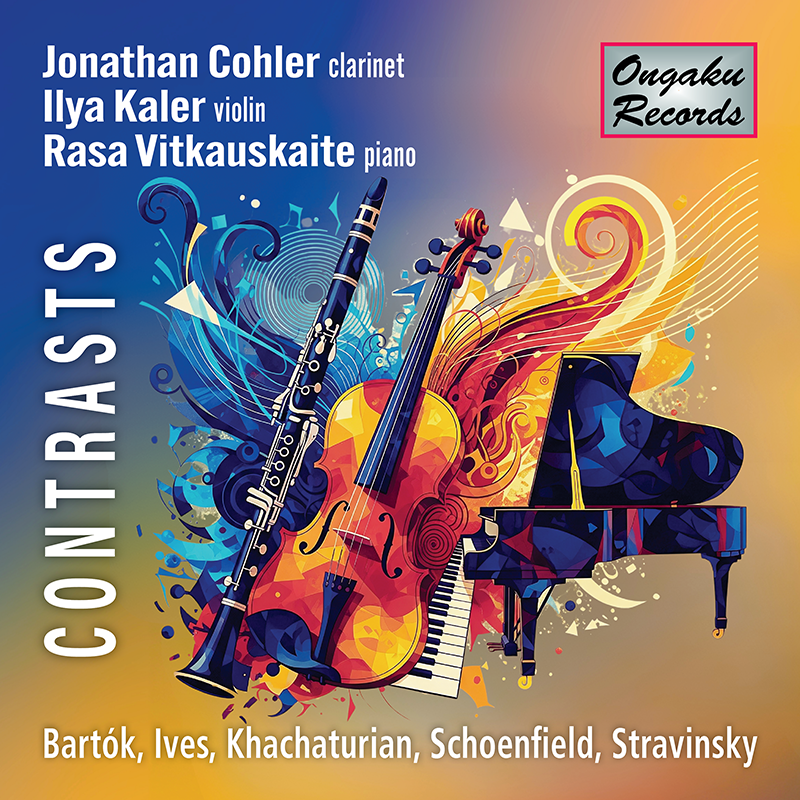“...outstanding release...If the Schoenfield Trio is the major discovery on this release, the Bartók is its soul. Cohler leads a lovely reading filled with sensitivity and nuanced musicianship, which is true of everything here...
Cohler’s longtime piano partner, Rasa Vitkauskaite, is of soloist caliber and has a burgeoning career on her own. Here she adapts her style seamlessly with each composer, and when given the opportunity to deliver virtuoso passages in the Schoenfield, she spectacularly seizes the limelight. The Russian-born violinist Ilya Kaler has the unique distinction of winning gold at the Tchaikovsky, Sibelius, and Paganini competitions, which he accomplished between 1981 and 1986. Not only is he superlative here, but he contributes to an ensemble that rivals the best in the recorded legacy of Contrasts.
... [Cohler’s] scintillating clarinet playing is allowed free, exuberant rein...
The strong recommendation I’m giving is aimed at general listeners as much as clarinet aficionados—something unique and special happens here.”
★★★★★
—Huntley Dent, Fanfare
“This is a disc that reflects thoughtful programming with terrific performances ... energetic, stylish, committed, and highly skilled playing
of all three principals. The music makes a broad range of demands on the performers. The
Schoenfield opens with a movement called “Freylakh,” a Yiddish word meaning joyful and
reflective of an upbeat klezmer dance. The unbuttoned performance here might make you think
that you’ve been dropped into a Jewish wedding. The third movement, “Niggun,” is deeply
expressive and inward looking, and played with intimacy and restraint. It is that mastery of the entire gamut of moods and emotions reflected in the program that
makes this disc so successful. In an earlier review of a recording of Mozart’s Clarinet Concerto
played (and conducted) by Cohler, Huntley Dent remarked “for me the virtue of this recording is
its sense of joy in music-making.” That goes here for not only Cohler, but his two colleagues as
well. The three have played together over many years, and as a result they think and breathe as
one ... Again the music [Khachaturian] requires a
performance capable of poetry on the one hand and vigor on the other, and receives it here.
The Bartók performances honors both its Hungarian roots and the influence of American
jazz. The alternation between slow and fast sections of the first movement, “Verbunkos,” is seamlessly executed ... Essential to the success of the Stravinsky is violinist Kaler’s slinky sensuality in the
“Tango,” the feverish intensity of the “Devil’s Dance,” and once again that sensation that all
three performers are simply having a ball ...
The performance of the Ives Largo is particularly sensitive ... Again, the performers deliver it all.
The recorded sound is ideally balanced, and there are excellent program notes on the
label’s website. It is a great pleasure to come across a recording as well planned and executed as
this.”
★★★★★
“An intelligently programmed and superbly performed disc.”
—Henry Fogel, Fanfare
“Cohler’s technical strengths and pellucid tone are, as
always, in evidence in his playing, but he also brings out the sass, spice, and tart flavors of
Bartók’s intentional bitonal seasonings ... Cohler, violinist Ilya Kaler, and pianist Rasa Vitkauskaite deliver with a
real flair ... The Stravinsky is superbly well done... Ongaku’s recording is very detailed, transparent, and does a good job of keeping the instruments
each its own acoustic space ... three musicians in top form, playing with superb technical control and a consummate understanding of the music... The glassy-sounding
glissandos are positively gauzy, gossamer, ghostly, and grim... I love it... this is a disc to treasure. Jonathan Cohler has always impressed me as being in the top rank of world class clarinetists, and this release has only further reinforced that opinion... these works pose extreme technical difficulties, which Cohler surmounts with seeming ease, at all time maintaining poise, an elegant beauty of tone, and the highest degree of musicianship. But in these works it takes three to Kozatzke, and the perfect timing between these players is nothing short of breathtaking in their rhythmic coordination and their reciprocity and mutuality of musical expression. In Ilya Kaler, violin, and Rasa Vitkauskaite, piano, Cohler has chosen his partners well.”
★★★★★
“A must-have for all who take a serious interest in music for clarinet, violin, and piano.”
—Jerry Dubins, Fanfare
“What a way to begin a disc! ...as crazy as it is effusive. Jonathan Cohler, Ilya Kaler and Rasa ... nail the
zaniness ... Ilya Kaler plays beautifully up high; the three meld as one ...
With these guys, there is no doubt this is a dance (a “Freylakh”) ... The “March” is brilliantly
quirky here with Vitkauskaite tremendously characterful: she is never background, always
colorful ... There is a sense of freedom
here that is most enthralling, and Kaler really digs into the double-stops, Cohler’s clarinet
wailing and shrieking in approval ... we hear the give and take of seductive sway beautifully here
... “Niggun”
references the Ashkenazi Jewish vocal music of its title both clarinet and violin sing, and they
certainly do here, with Kaler’s violin almost vocal. A heart-stopping moment is a sustained
double-stop on violin, low piano and a clarinet lament: so beautiful here ... Vitkauskaite
is the most sensitive pianist ... The violin part is massively difficult, and Kaler polishes it off with ease, while Cohler’s clarinet
sings with its customary lyricism ... It is
Cohler who shines at the opening of the finale (Moderato), with Vitkauskaite subsequently
finding a surprisingly jazzy feel to the piano’s riposte .. the new
release is markedly superior to [others] both in terms of interpretative truth and sheer
recording quality ... the new performance’s combination of nous and
sophistication is most appealing. There is the same sense of three performers who know each
other inside out about this Contrasts; just listen to the pure attunement of clarinet and violin at
the opening of the second piece, and how that electricity is maintained going forwards ... This finale is one of the most convincing of all readings of
this movement. Despite the well-known recording by Bartók himself, Szigeti and Benny
Goodman, this new recording stands firmly on its own two feet ... Kaler can conjure up a dance hall in a second, then twist it through a distorting mirror.
“The Devil’s Dance” is properly infernal ...
Finally, a rarity: a Largo by Charles Ives ... Kaler who takes the lead, finding just the right sweet
spot; Cohler’s entrance is perfectly placed ... What a
great piece, and what a great way to close the disc.”
★★★★★
“A winner. Despite serious competition, this disc holds its head way high.
Recommended.”
—Colin Clarke, Fanfare
“the polish and nuance that long years of thoughtful interaction with
the repertoire and among the musicians ...
Clarinetist Jonathan Cohler gave the Boston premiere of the Schoenfield Trio nearly 30
years ago, when it was still quite a new work ... The interpretations on this album are highly developed ... Ilya Kaler’s approach to the
double-stops that open the Contrasts’ finale are not gruff; they are energetic and suave, as if in a
danse macabre. The performance of Contrasts as a whole enthusiastically embraces its debt to
folk music; in these double-stops, though, we hear it as an heir to the virtuoso violin writing of
the 19th century. In the Schoenfield, the trio is so attuned to issues of balance that, even in the
most intricately overstuffed passages, the ear can readily follow each instrument’s activity ... The effects—clarinet pitch-bends; piano glissandos and
clusters; extended high-register passages in the violin—sound not just natural but inevitable
rather than advertising or exoticizing the composer’s use of klezmer techniques, the playing
treats them as an expressive tool within a concert work that, though it has a cultural context, is an
independent piece of art rather than a metaphor of musical Jewishness ... though Schoenfield makes some pretty steep demands of all
three instrumentalists, I am particularly struck by the endurance required by the pianist; Rasa
Vitkauskaite’s playing sparkles in a seemingly endless whirlwind of figuration throughout the
first movement, and in an aerobic marathon of driving rhythms in the finale.
The musicians’ knack for listening to each other, picking up each other’s emotional cues,
yet remaining soloistic in their approach to their instruments, is especially clear in the dance-like
middle movement of the Khachaturian Trio ... Equally impressive is each musicians’ range of timbre and effect, as when the
violin engages in dialogue with itself in the “Tango-Valse-Rag” movement of the Stravinsky
Suite ... Likewise, Cohler
brings an almost trumpet-like timbre to the high clarinet fanfares in the Suite’s “Petit Concert”
movement.
Perhaps the nicest surprise on the album is the trio’s performance of Ives’s Largo ... Ilya
Kaler’s legato is even more smooth and aria-like; numerous other recordings, from the Seattle
Chamber Music Society to the Boston Symphony Chamber Players, take a motoric approach to
Ives’s rhythms, treating it as technique-focused rather than expression-focused music. Excellent sound quality makes for a concert-like experience of this recording ... this is an immensely satisfying recording, and I give it a
wholly enthusiastic recommendation.”
★★★★★
“Passionate, polished playing.”
—Myron Silberstein, Fanfare
“This CD brings together three of Ongaku Records’s veteran performers ... [and] encompasses the best-known
works for violin, clarinet, and piano, and also includes the late Paul Schoenfield’s (1947–2024)
Trio, which appears to be gaining in popularity ... The piece features many
slides and glissandos, and is quite difficult to perform. Kaler, Cohler, and Vitkauskaite display
not only a solid command of the technical side, but also a firm grasp of the stylistic aspects ... Kaler’s playing is pure and Cohler’s sound is vibrant ... The
musicians are all uncannily accurate, including in the uneven-meter section of the third
movement [of Bartok] ... The trio version [Stravinsky], however, requires technical
virtuosity from both violinist and clarinetist, and Kaler and Cohler deliver in spades; Cohler is
particularly impressive in the clarinet’s altissimo register ... The entire recital is played superbly; the recording is admirable
and the balances ideal ... this is the first CD to include all five of these
works. As such it includes the most significant works for violin, clarinet, and piano, and it does
so at the highest level. Strongly recommended.”
★★★★★
“Virtuosity, at the highest level.”
—Richard A. Kaplan, Fanfare
“The first thing you hear on this album is a dazzling, hectic run ... the thrilling, comedic and virtuosic beginning to Paul Schoenfield’s Trio for
Violin, Clarinet and Piano, wonderfully played here, a riveting start to an enlightening album of music
for this unique combination of instruments ... Cohler, Kaler and Vitkauskaite are shiveringly effective here ... Cohler’s deeply expressive clarinet ... [they] capture the wild exuberance Schoenfield was surely seeking
brilliantly, and their commitment to Schoenfield’s sophisticated treatment of his material is a joy to
behold ... Cohler’s deliberately plain, almost ingenuous statement of the theme [in the Khachaturian], another folk melody,
intercepted by Vitkauskaite’s sharply played rhythmic figure, leading to a highly diverting set of
Variations played with wit and sensitivity. It’s a scintillating account.
Bartók’s Contrasts is next, a piece commissioned by Benny Goodman in 1938. This is probably
the best-known work on the disc but what is striking about the performance of Cohler, Kaler and
Vitkauskaite is the freshness and sense of discovery they bring to it. It really sounds as if they have
disassembled the work and put it back together again. Just listen to how they approach the first
movement, “Verbunkos”, Kaler’s violin making light of Bartók’s demands, reeling off arpeggios,
tremolos and multiple stopping, Vitkauskaite’s piano articulating the syncopated piano writing with the
stride piano idiom absolutely nailed and Cohler’s masterful playing of the cadenza at the end ... the cadenza in this movement is also superbly executed [by Kaler] ... there’s no question about the level of care
Cohler, Kaler and Vitkauskaite have taken in their preparation to be able to deliver on Ives’s precise and
frequent tempo and dynamic markings. The degree of technical control that all three demonstrate is
remarkable and the atmosphere engendered lingers in the memory, from Kaler’s lyricism, sometimes
tinged with a deliberately hesitant and questioning quality; to Cohler’s beautifully blended sound which
has a wistful sense of nostalgia about it; and Vitkauskaite’s poised and controlled playing which is so
important for the work’s unique harmonic effect, as well as being a full partner in the instrumental
conversation. It’s a highly thoughtful, affirmative way to end the recital ... What a revelation this album has been, especially when heard in the superb sound my hi-resolution download provided. Jonathan Cohler’s first-rate liner notes have added hugely to my
experience, that feeling of stimulation you get from the best teachers and experts ... I kept asking myself why nobody (as far as I know) had put these works
together before ... I don’t think anybody could have done it better than these
performers.
★★★★★
“The ‘pillars’ of the violin, clarinet, piano genre; essential for any library of
chamber music.”
—Dominic Hartley, Fanfare
“This truly remarkable release spans virtually the entire 20th century—from the Ives
“Largo” from 1902 to the Paul Schoenfield (1947-2024) trio completed in the 1990s ... The energy level Cohler, Kaler, and Vitkauskaite bring to the Schoenfield trio carries
over to the album’s other pieces as well ... I hadn’t thought anyone would ever surpass the 1940 Columbia
recording of Bartók’s Contrasts by the people for whom he wrote it: himself on piano, Joseph
Szigeti on violin, and Benny Goodman on clarinet ... If this
group haven’t bettered the Bartók-Szigeti-Goodman recording, they’ve certainly equaled it for
sheer passion and energy, and they have the advantage of 84 years’ worth of improvements in
sound technology ... an excellent presentation of this
difficult and quirky score [Stravinsky].
Ives’s Largo ... closes the
album with a surprising degree of repose ... this is an extraordinary
album ... Cohler, Kaler, and Vitkauskaite play
magnificently, and the sonics are transparent enough to catch the interplay between them
perfectly. Enthusiastically recommended.
★★★★★
“Brilliant, energetic performances of 20th century music for clarinet, violin, and piano.”
—Mark Gabrish Conlan, Fanfare
CLICK HERE for track details
